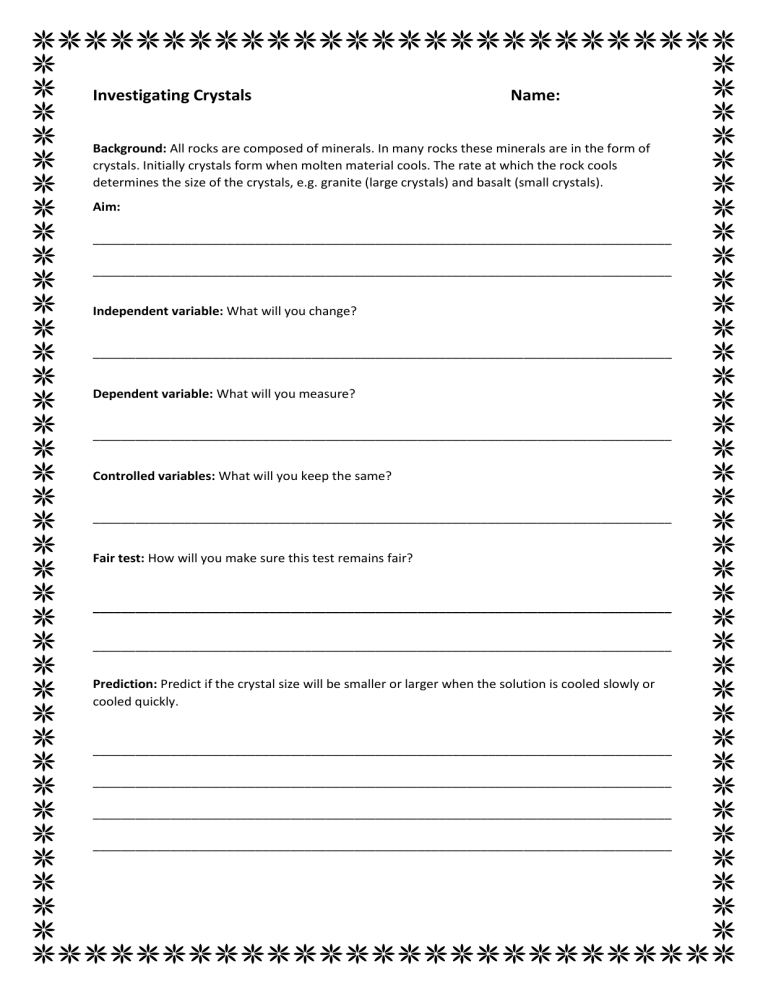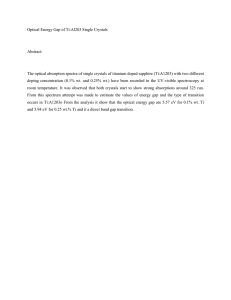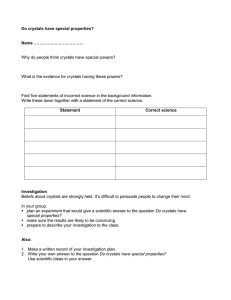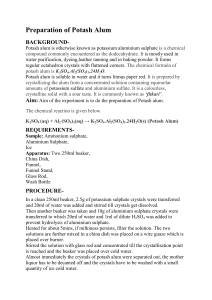Investigating the role of heat in crystal formation
advertisement

Investigating Crystals Name: Background: All rocks are composed of minerals. In many rocks these minerals are in the form of crystals. Initially crystals form when molten material cools. The rate at which the rock cools determines the size of the crystals, e.g. granite (large crystals) and basalt (small crystals). Aim: __________________________________________________________________________________ __________________________________________________________________________________ Independent variable: What will you change? __________________________________________________________________________________ Dependent variable: What will you measure? __________________________________________________________________________________ Controlled variables: What will you keep the same? __________________________________________________________________________________ Fair test: How will you make sure this test remains fair? __________________________________________________________________________________ __________________________________________________________________________________ Prediction: Predict if the crystal size will be smaller or larger when the solution is cooled slowly or cooled quickly. __________________________________________________________________________________ __________________________________________________________________________________ __________________________________________________________________________________ __________________________________________________________________________________ Materials: For each group personal protective equipment (PPE), including safety glasses 1 x beaker 2 x test tubes Bunsen burner matches crushed ice in a 250 mL beaker thermometer prepared saturated solution of aluminium potassium sulphate (alum) 10–15 g of aluminium potassium sulphate, in solid form spatula Risk assessment: What risks can you identify in this investigation? What measures can be taken to minimise the risks? Personal safety Other safety glasses Report all spills and breakages. gloves Dispose of chemicals correctly by placing in ice cream bucket hair tied back closed shoes What are the risks? How will you manage them? handling chemical compounds Wear PPE. e.g. aluminium potassium sulphate Collect waste — do not put down drains. Method: 1. Half fill a beaker with the saturated solution of your chosen chemical compound. 2. Add one spatula of your solid chemical compound to the solution. 3. Using a tripod and gauze mat, heat the solution gently over a Bunsen burner flame, stirring the solution to dissolve the compound. (Note: Take care as the mixture begins to boil, it may bubble up.) 4. Repeat steps 2 and 3 until no more solid compound will dissolve in the solution. 5. Divide the contents evenly between two clean test tubes. 6. Place one test tube into a larger beaker of crushed ice to cool the contents immediately. 7. Leave the other test tube to cool down slowly in an empty beaker. 8. Inspect the contents of both test tubes the next day. 9. Draw and label a diagram of the crystal size from each test tube. Data collection: How will you record your observations? Draw a diagram of quickly cooled crystals. Draw a diagram of slowly cooled crystals. Discussion: Data: What does your data tell you? Were the results consistent with your prediction? __________________________________________________________________________________ __________________________________________________________________________________ __________________________________________________________________________________ __________________________________________________________________________________ Describe the effect of cooling rate on the size of crystals formed. __________________________________________________________________________________ __________________________________________________________________________________ __________________________________________________________________________________ __________________________________________________________________________________ Were the results consistent with your prediction? Explain your response. __________________________________________________________________________________ __________________________________________________________________________________ __________________________________________________________________________________ Under what circumstances would a rock cool quickly or slowly? __________________________________________________________________________________ __________________________________________________________________________________ __________________________________________________________________________________ Why does the cooling rate affect the size of crystals? (Hint: Think about what is happening at the particle level.) __________________________________________________________________________________ __________________________________________________________________________________ __________________________________________________________________________________ Evaluating the experimental method: What aspects of the method did not work well? __________________________________________________________________________________ __________________________________________________________________________________ Conclusion: Write a sentence or two summarising the connection between the results and the aim of the investigation. __________________________________________________________________________________ __________________________________________________________________________________ __________________________________________________________________________________ __________________________________________________________________________________




